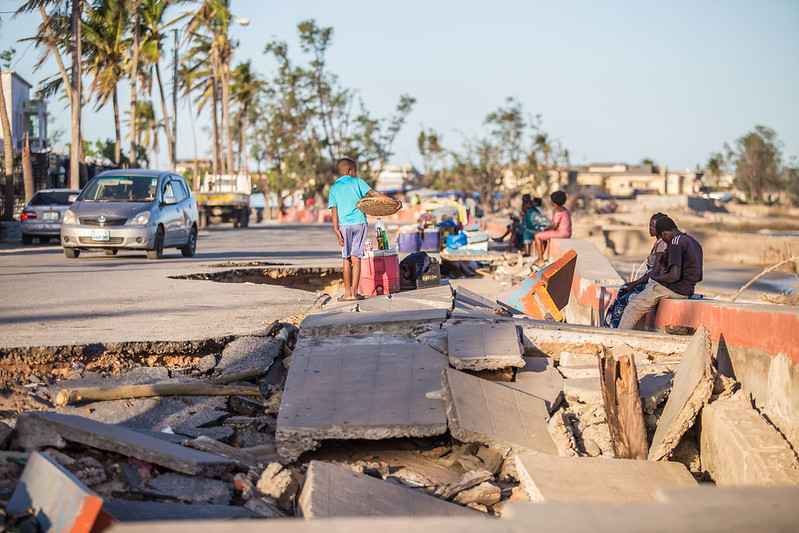Fighting extreme weather in Africa with big data
Knowledge is power in matters of climate adaptation, which is why a new programme that gathers continent-wide information on water could be a game-changer for the way Africa tackles droughts and floods.
A
bout this time last year, Malawi, Mozambique and Zimbabwe were reeling from Cyclone Idai, a severe flood. Zimbabwe is currently facing the opposite: a devastating drought, leaving millions without power and on the brink of starvation.
Such water extremes are not new in Sub-Saharan Africa but they are likely to become more frequent and more intense in the years ahead, as rising temperatures make climate change adaptation a matter of life or death.
It is no longer possible to prepare for the traditional wet and dry seasons of the past. As Zimbabwe has found out, one year could bring unprecedented storms while the next brings record water scarcity.
Big data to monitor water
Instead, Africa’s best hope may come in the form of big data, and monitoring water resources so that countries can take more informed decisions to better weather the storm and survive the drought.
This year’s World Water Day (22 March), focused on how water and climate change are inextricably linked. The devastating impact of Cyclone Idai in Zimbabwe in particular offers a vivid example of how climate change is linked to the abundance and scarcity of water.
And when it comes to adapting to climate change, knowledge is power, which is why a new programme to gather continent-wide information on water could be a game-changer.
A satellite imagery platform called Digital Earth Africa has previously focussed on land resources such as forests. But it will now aggregate data from remote-sensing technologies, which will allow scientists at the International Water Management Institute (IWMI) to develop applications for detailed analysis on continent-wide water levels and supplies.
Crucially, this information will be held in the Open Data Cube, an open-source resource for earth observation data, which will give unprecedented levels of access to information on the situation across Africa.

In Beira, Mozambique, Cyclone Idai caused extensive damage to the city’s infrastructure. Photo by World Bank / Sarah Farhat
Pooling information
By pooling this information and making it publicly available, it will be possible to create an accurate picture of water resources to forecast shortages and water needs, and develop strategies to manage water-related climate risks.
For example, such data, collected over decades and amounting to huge capacities, will allow governments to assess, monitor and report on water resource availability and use, and to balance water allocations across different sectors including agriculture and health.
It will also help scientists such as those at the IWMI to develop extreme scenario models, enabling authorities to take a “prevention is better than cure” approach.
As well as water accounting, the International Water Management Institute (IWMI) researchers will be able to make use of the data to create flood and drought models that can then be used to develop early warning systems, not just within counties or districts but across wider regions.
When Cyclone Idai struck, it impacted an area from the coast of central Mozambique beyond the Zimbabwe border and the southern tip of Malawi, all requiring different levels of response but which could have benefitted from greater coordination across the region.
Similarly, the disaster led to flooding of the Zambesi and Limpopo rivers, which run through multiple countries including Botswana. By better using regional data, these climate disasters can be handled and addressed in a more coherent way at a large scale.
New systems will aim to give sufficient notice of imminent extremes so that families can evacuate from an area facing a flood or storm, for example, or claim against drought-related insurance.
These applications will be rolled out in some countries with a view to developing additional services and extending them across the continent.
Helping African innovation and digitalisation
Finally, beyond developing applications and working with partners, the IMWI also sees enormous potential to support African-grown innovations to develop water-related tools that benefit countries, communities and businesses.
While there is a growing community of data science, start-ups and digitalisation in Africa, there is also a gulf between the potential of new data technologies to improve water resource management in Africa and the realities of their limited application on the ground.
To realise its promise and help build resilience to water extremes, this project would also need to overcome barriers to adoption such as awareness, expertise and cost in using the data.
But given that water is so intrinsically linked to climate change and impacts food, economic and social security, it is vital that we work together to develop systems to manage and secure water resources, allowing countries across Africa to thrive.
In climate change-induced emergencies such as floods and droughts, tools and technologies that aid their effective management can be the difference between sinking and swimming.
The ideas presented in this article aim to inspire adaptation action – they are the views of the author and do not necessarily reflect those of the Global Center on Adaptation.